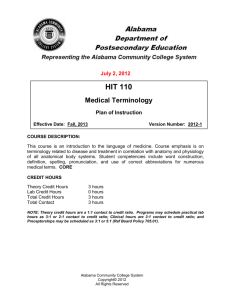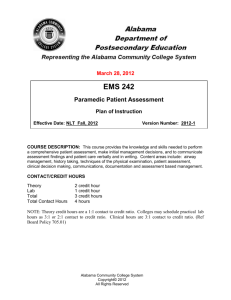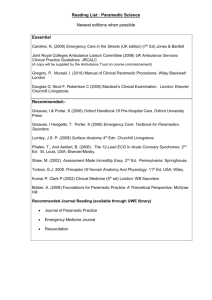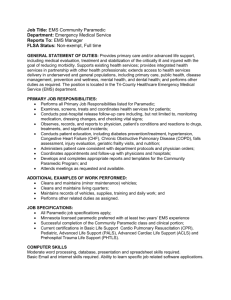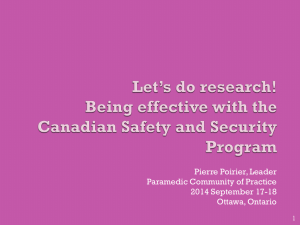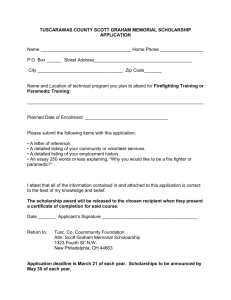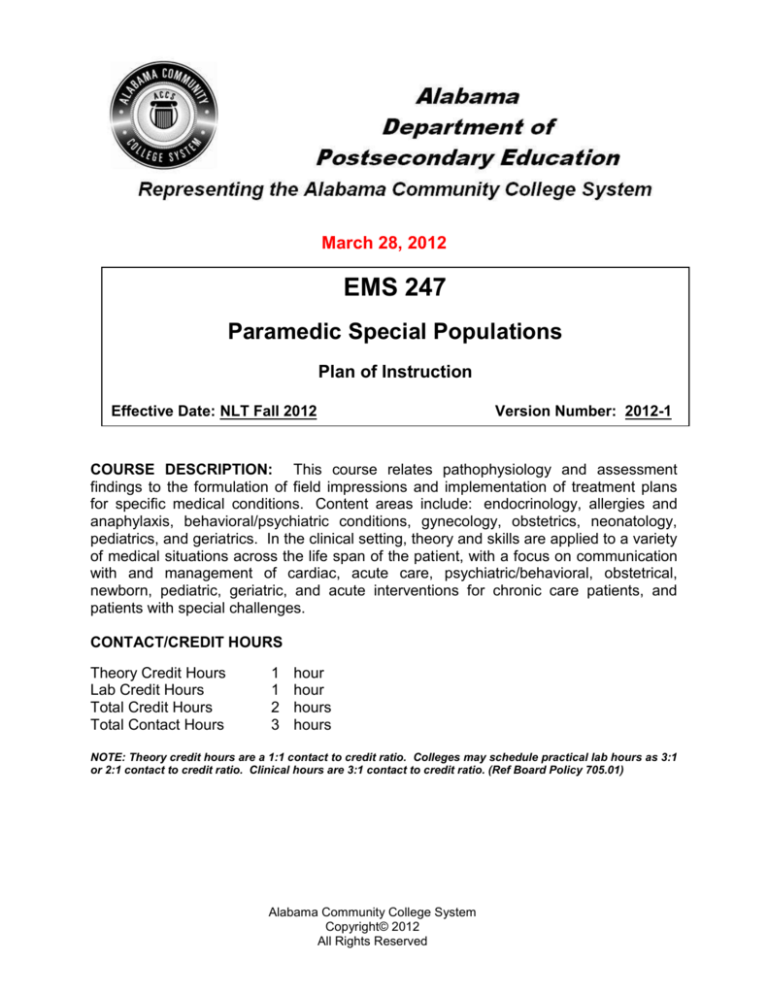
March 28, 2012
EMS 247
Paramedic Special Populations
Plan of Instruction
Effective Date: NLT Fall 2012
Version Number: 2012-1
COURSE DESCRIPTION: This course relates pathophysiology and assessment
findings to the formulation of field impressions and implementation of treatment plans
for specific medical conditions. Content areas include: endocrinology, allergies and
anaphylaxis, behavioral/psychiatric conditions, gynecology, obstetrics, neonatology,
pediatrics, and geriatrics. In the clinical setting, theory and skills are applied to a variety
of medical situations across the life span of the patient, with a focus on communication
with and management of cardiac, acute care, psychiatric/behavioral, obstetrical,
newborn, pediatric, geriatric, and acute interventions for chronic care patients, and
patients with special challenges.
CONTACT/CREDIT HOURS
Theory Credit Hours
Lab Credit Hours
Total Credit Hours
Total Contact Hours
1
1
2
3
hour
hour
hours
hours
NOTE: Theory credit hours are a 1:1 contact to credit ratio. Colleges may schedule practical lab hours as 3:1
or 2:1 contact to credit ratio. Clinical hours are 3:1 contact to credit ratio. (Ref Board Policy 705.01)
Alabama Community College System
Copyright© 2012
All Rights Reserved
Paramedic Special Populations
EMS 247
PREREQUISITE COURSES
As determined by college.
CO-REQUISITE COURSES
As determined by college.
PROFESSIONAL COMPETENCIES
INSTRUCTIONAL GOALS
Cognitive – Comprehend the role of medications in the care of the sick, ill, and
injured as a Paramedic
Psychomotor – Demonstrate competency of calculating the correct medication
dose and medication administration techniques via the enteral (alimentary tract)
and parenteral routes.
Affective – Value the importance of following guidelines and procedures for the
administration of drugs by a paramedic to affect positive therapeutic effect.
STUDENT OBJECTIVES
Condition Statement:
The instructional guidelines for the Paramedic level include all related topics and
material at the AEMT and EMT level to a complex depth and comprehensive breadth
plus information contained in this document.
ACCS Copyright© 2012
All Rights Reserved
2
Paramedic Special Populations
EMS 247
STUDENT LEARNING OUTCOMES
SPECIAL POPULATIONS
PROFESSIONAL COMPETENCIES
PERFORMANCE OBJECTIVES
Provide care for patients experiencing
various medical emergencies.
Value the importance of thorough and
accurate assessment and management
of care for special populations.
KSA
Conduct an assessment, formulate a
management and disposition plan, and
implement the plan for the following special
populations:
Obstetrics patient
Neonatal patients
Pediatric patients
Geriatric patients
Patients with special challenges
This module is measured affectively.
3
A
LEARNING OBJECTIVES
Differentiate between the various types and categories of special population patients.
Discuss the assessment and management of special population patients.
See National Emergency Medical Services Education Standards Paramedic Instructional
Guidelines for associated detailed outline content.
2
3
LEARNING OUTCOMES TABLE OF SPECIFICATIONS
The table below identifies the percentage of learning objectives for each module. Instructors
should develop sufficient numbers of test items at the appropriate level of evaluation.
Limited
Knowledge and
Proficiency
Moderate
Knowledge and
Proficiency
Advanced
Knowledge and
Proficiency
Superior
Knowledge and
Proficiency
1
2
3
4
-
50%
50%
-
ACCS Copyright© 2012
All Rights Reserved
3
Paramedic Special Populations
Indicator Key Terms
1
Limited
Knowledge
and
Proficiency
2
Moderate
Knowledge
and
Proficiency
3
Advanced
Knowledge
and
Proficiency
4
Superior
Knowledge
and
Proficiency
A
Affective
Objective
ACCS Copyright© 2012
All Rights Reserved
EMS 247
Learner’s Knowledge, Skills and Abilities
Description
Recognize basic information about the subject including terms
and nomenclature.
Students must demonstrate ability to recall information such as
facts, terminology or rules related to information previously
taught.
Performs simple parts of the competency. Student requires
close supervision when performing the competency.
Distinguish relationships between general principles and facts.
Adopts prescribed methodologies and concepts.
Students must demonstrate understanding of multiple facts
and principles and their relationships, and differentiate between
elements of information. Students state ideal sequence for
performing task.
Performs most parts of the competency with instructor
assistance as appropriate.
Examines conditions, findings, or other relevant data to select an
appropriate response.
The ability to determine why and when a particular response is
appropriate and predict anticipated outcomes.
Students demonstrate their ability to seek additional information
and incorporate new findings into the conclusion and justify their
answers.
Performs all parts of the competency without instructor
assistance.
Assessing conditions, findings, data, and relevant theory to
formulate appropriate responses and develop procedures for
situation resolution. Involves higher levels of cognitive
reasoning.
Requires students to formulate connections between relevant
ideas and observations.
Students apply judgments to the value of alternatives and select
the most appropriate response.
Can instruct others how to do the competency.
Performs competency quickly and accurately.
Describes learning objectives that emphasize a feeling tone, an
emotion, or a degree of acceptance or rejection.
Objectives vary from simple attention to selected phenomena to
complex but internally consistent qualities of character and
conscience.
Expressed as interests, attitudes, appreciations, values, and
emotional sets or biases.
4

